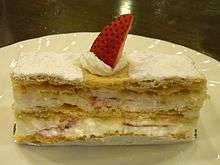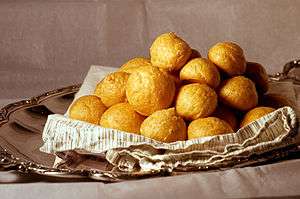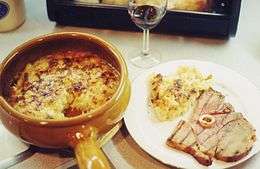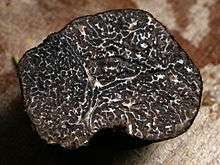List of French dishes
There are many dishes considered part of French cuisine. Some dishes are considered universally accepted as part of the national cuisine, while others fit into a unique regional cuisine. There are also breads, charcuterie items as well as desserts that fit into these categories which are listed accordingly as well.
Common dishes found on a national level
There are many dishes that are considered part of the French national cuisine today. Many come from haute cuisine in the fine-dining realm, but others are regional dishes that have become a norm across the country. Below are lists of a few of the more common dishes available in France on a national level.
Common breads of France
Common desserts and pastries

- Bûche de Noël
- Café liégeois
- Clafoutis
- Crème brûlée
- Croquembouche
- Éclair
- Far Breton
- Fraisier
- Galette des rois
- Gateau au yaourt
- Macarons
- Madeleine
- Mille-feuilles
- Mousse au chocolat
- Pain au chocolat
- Pain perdu
- Quatre-quarts
- Saint Honoré
- Soufflé
- Tarte Tatin
Lorraine
- Baba au rhum
- Bouchée à la reine (Shell puff pastry with cream sauce and chicken)
- Crepe et fruit
- Fuseau lorrain
- Glace Plombières
- Pâté lorrain
- Macarons de Nancy
- Madeleine (small traditional cake from Commercy with orange blossom)
- Potée Lorraine
- Quiche Lorraine (traditional tart with bacon, eggs and cheese)
- Tarte à la brimbelle (Myrtille)
- Tarte à la mirabelle
- Tête de veau
- Tourte
Alsace

- Baeckeoffe
- Carpe frites
- Choucroute garnie (sauerkraut with sausages, salt pork and potatoes)
- Coq au Riesling (the local Alsace variant of coq au vin)
- Knack / saucisse de Strasbourg
- Kouglof (traditional brioche cake with almonds baked in a special bell shaped mould)
- Presskopf
- Rosbif à l'alsacienne (horsemeat)
- Spätzle
- Tarte à l'oignon
- Tarte flambée / Flammekueche
Normandy
- Matelote (fish stewed in cider)
- Moules à la crème Normande (mussels cooked with white wine, Normandy cider, garlic and cream)
- Tarte Normande (apple tart)
- Teurgoule (a baked rice dessert)
- Tripes à la mode de Caen (tripe cooked in cider and calvados)
Aquitaine
Limousin
- Farcidure
- Flaugnarde
- Fondu creusois
- Paté de pomme de terre
- Tourtous aux rillettes d'oie
Brittany

- Crêpes (a very thin type of pancake, often eaten filled with sweet or savory fillings)
- Far Breton (flan with prunes)
- Kig ha farz (boiled pork dinner with buckwheat dumplings)
- Kouign amann (galette made flaky with high proportion of butter)
- Poulet à la bretonne (chicken simmered in apple cider)
Loire Valley/Central France
- Andouillettes (sausage made with chitterlings)
- Rillettes (spreadable paste made from braised pork and rendered fat, similar to pâté)
Burgundy

- Bœuf bourguignon (beef stewed in red wine)
- Coq au vin (chicken braised in red wine, lardons and mushrooms)
- Escargots de Bourgogne (snails baked in their shells with parsley butter)
- Gougère (cheese in choux pastry)
- Jambon persillé (also known as Jambon de Pâques, a marbled ham with parsley)
- Oeufs en meurette (poached eggs in a red wine and pepper reduction sauce)
- Pôchouse (pauchouse; fish stewed in red wine)
Rhône-Alpes

- Andouillette (a kind of sausage with tripe)
- Fondue savoyarde (fondue made with cheese and white wine into which cubes of bread are dipped)
- Gratin dauphinois (a traditional regional French dish based on potatoes and crème fraîche)
- Quenelle (flour, butter, eggs, milk and fish, traditionally pike, mixed and poached)
- Raclette (the cheese is melted and served with potatoes, ham and often dried beef)
- Soupe à l'oignon (onion soup based on meat stock, often served gratinéed with cheese on top)
- Tartiflette (a Savoyard gratin with potatoes, Reblochon cheese, cream and pork)
Aveyron/Cantal
- Aligot (mashed potatoes blended with young Tomme cheese)
- Tripoux (tripe 'parcels' in a savoury sauce)
- Pansette de Gerzat (lamb tripe stewed in wine, shallots and blue cheese)
- Salade Aveyronaise (lettuce, tomato, roquefort cheese, walnuts)
- Truffade (potatoes sautéed with garlic and young Tomme cheese)
- Fouace (orange blossom water cake)
- Flaune (crust pastry dough filled with a mixture of eggs, sugar and orange blossom water, it looks like cheesecake)
- Farçous (salt and pepper mince made with pork meal, Swiss chard, parsley, eggs and flour)
- Soupe au fromage (soup with onions, garlic, cabbage, vine, stale bread, salt and pepper)
- Pascade (salted pancake)
Toulousain
Languedoc-Roussillon
- Bourride (white fish stewed with vegetables and wine, garnished with aïoli)
- Brandade de morue (puréed salt cod)
- Cargolade (Catalan style of escargot)
- Clapassade (lamb ragout with olives, honey and licorice)
- Encornets farcis (cuttlefish stuffed with sausage meat, herbs)
- Rouille de seiche (squid prepared in a similar way to bourride)
- Trinxat (Catalan cabbage and potatoes)
Provence-Alpes-Côte d'Azur

- Aïoli (sauce made of garlic, olive oil, lemon juice, and egg yolks)
- Bouillabaisse (a stew of mixed Mediterranean fish, tomatoes, and herbs)
- Calisson (famous candy from Aix-en-Provence)
- Chichi (French churro)
- Daube provençale (a braised stew of beef, vegetables, garlic, and wine)
- Fougasse (a type of bread, often found with additions such as olives, cheese, or anchovies)
- Gateau des rois (tortell, provençal variant of the king cake with glazed fruit)
- Gibassier (galette made with olive oil and spiced with anise, candied orange peel, and orange flower water, and dusted with baker's sugar)
- Navette (from Marseille)
- Oreilette (beignet eaten during carnival or Christmas)
- Pan-bagnat (sandwich with whole wheat bread, salade, hard boiled eggs, tomatoes, tuna or anchovies and olive oil)
- Panisses
- Pieds paquets (lambs’ feet and tripe ‘parcels’ in a savoury sauce)
- Pissaladière (an antecedent of the much more popular pizza)
- Pompe à l'huile also called Fouace in Occitan (galette made with olive oil; one of the thirteen desserts of a Provençal Christmas)
- Quince cheese (a jelly-like confection made from the quince fruit)
- Ratatouille (a vegetable stew with olive oil, aubergine, courgette, bell pepper, tomato, onion and garlic)
- Salade Niçoise (various ingredients, but always with black olives and tuna)
- Socca (unleavened crepe made from chickpea flour, common along the Ligurian Sea coast both in France and Italy).
- Soupe au pistou (bean soup served with a pistou (cognate with Italian pesto) of fine-chopped basil, garlic and Parmesan)
- Tapenade (puree or finely chopped olives, capers, anchovies and olive oil)
- Tarte tropézienne (famous tarte from Saint-Tropez)
French cuisine ingredients



French regional cuisines use locally grown vegetables, such as:
Common fruits include:
Meats consumed include:
Eggs are fine quality and often eaten as:
- Hard-boiled with mayonnaise
- Omelette
- Scrambled plain or haute cuisine preparation
Fish and seafood commonly consumed include:
Herbs and seasonings vary by region and include:
Fresh fruit and vegetables, as well as fish and meat, can be purchased either from supermarkets or specialty shops. Street markets are held on certain days in most localities; some towns have a more permanent covered market enclosing food shops, especially meat and fish retailers. These have better shelter than the periodic street markets.
See also
Notes
References
- Newman, Bryan. Behind the French Menu. French cuisine explained, 2013
- Steele, Ross. The French Way. 2nd edition. New York: McGraw-Hill, 2006.
